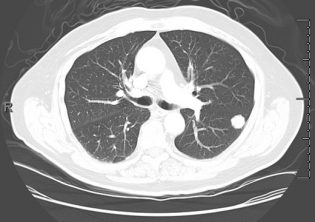Pulmonary nodule (A spot on the lung)
What is a pulmonary nodule?
— A pulmonary nodule, also called a lung nodule, is a “spot” on the lungs that is seen on a chest X-ray or CT scan. A CT scan is an imaging test that creates pictures of the inside of the body. If there is only 1 spot, it’s called a “single” (or “solitary”) pulmonary nodule. A single pulmonary nodule usually causes no symptoms. People find out they have it after they have a chest X-ray or CT scan done for another reason.What causes a pulmonary nodule?
— A pulmonary nodule is caused by either:- A condition that is not cancer – In most cases, a pulmonary nodule is not cancer. It is a growth, small area of infection, or old scar in the lungs. Some medical terms for these things include “granuloma,” which is an area of inflammation, and “hamartoma,” which is a non-cancerous growth.
- Cancer – A pulmonary nodule can be lung cancer, which is when normal cells in the lungs change into abnormal cells and grow out of control. It can also be cancer that started in another part of the body and then spread to the lungs.
How will my doctor know whether my pulmonary nodule is cancer or not?
— To help figure this out, your doctor will use the following information:- Your age
- Whether you have other symptoms or other known cancers
- Whether you smoke or used to smoke
- Whether you have family members with lung cancer
- Whether you have worked with or around a material called asbestos
- The spot’s size and shape on the X-ray or CT scan
- Whether the spot has changed over time – To know this, your doctor will look at any old chest X-rays and CT scans you have.

